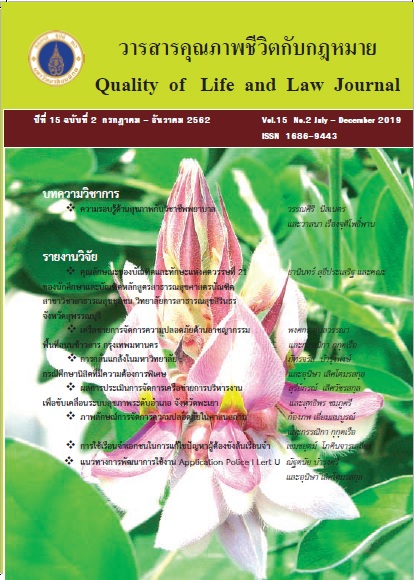Health Literacy and Nursing Professionals
Main Article Content
Abstract
Health literacy is an important factor on health status through life span both normal and abnormal states also affects on health behavior and health outcomes. It is an essential skill to achieve good health. The health literate individual can use skills needed to find, understand, evaluate, communicate and use health information. Nursing professionals work closely with both healthy people and patients by focusing on teaching, providing information, counseling and solving health problems. The scope of work covers individuals, families and communities. In addition, they work in all primary, secondary and tertiary health care centers. Therefore, nurses are important staff members of the health care team that can develop people’s health literacy.
This article aims to present the emphasis of health literacy, assessment, components and factors related to health literacy, guidelines for developing of health literacy and roles of nursing professionals on client’s health literacy enhancement. The more health literacy clients get, the better self-care behavior they gain. Therefore, they are healthier and pay less health care cost. Nurses can develop client’s health literacy by using the roles of assessor, health communicator, health media developer, creator of supportive environment for health literacy, encourager and researcher on health literacy issues.
Article Details
- บทความหรือข้อคิดเห็นใดๆ ในวารสารคุณภาพชีวิตกับกฎหมายเป็
- กองบรรณาธิการไม่สงวนสิทธิ์
References
กองสุขศึกษา กรมสนับสนุนบริการสุขภาพ กระทรวงสาธารณสุข. (2561). การเสริมสร้างและประเมินความรอบรู้ด้านสุขภาพและพฤติกรรมสุขภาพ. (ฉบับปรับปรุง). นนทบุรี: กระทรวงสาธารณสุข.
ขวัญเมือง แก้วดำเกิง. (2561). ความรอบรู้ด้านสุขภาพ เข้าถึง เข้าใจ และการนำไปใช้. (พิมพ์ครั้งที่ 2). กรุงเทพมหานคร: อมรินทร์พริ้นติ้ง.
ขวัญเมือง แก้วดำเกิง และดวงเนตร ธรรมกุล. (2558). การเสริมสร้างความรอบรู้ด้านสุขภาพในประชากรผู้สูงวัย. วารสารวิจัยทางวิทยาศาสตร์สุขภาพ, 9(2), 1-8.
ขวัญเมือง แก้วดำเกิง และนฤมล ตรีเพชรศรีอุไร. (2554). ความฉลาดทางสุขภาพ. กรุงเทพมหานคร: นิวธรรมดาการพิมพ์.
คณะกรรมการอำนวยการจัดทำแผนพัฒนาสุขภาพแห่งชาติ กระทรวงสาธารณสุข. (2559). แผนพัฒนาสุขภาพแห่งชาติ ฉบับที่ 12 กรุงเทพมหานคร: กระทรวงสาธารณสุข.
ชินตา เตชะวิจิตรจารุ. (2561). ความรอบรู้ทางสุขภาพ: กุญแจสำคัญสู่พฤติกรรมสุขภาพและผลลัพธ์สุขภาพที่ดี. วารสารพยาบาลทหารบก, 19(ฉบับพิเศษ), 1-11.
พระราชบัญญัติวิชาชีพการพยาบาลและการผดุงครรภ์ (ฉบับที่2) พ.ศ.2540. (2540). ราชกิจจานุเบกษา เล่มที่ 114, ตอนที่ 75ก (ลงวันที่ 13 ธันวาคม 2540).
วชิระ เพ็งจันทร์. (2560). ความรอบรู้ด้านสุขภาพ ในเอกสารการประชุมเชิงปฏิบัติการพัฒนาศักยภาพบุคลากรกรมอนามัย เรื่อง ความรอบรู้ด้านสุขภาพมุ่งสู่ประเทศไทย วันที่ 2 สิงหาคม พ.ศ. 2560. นนทบุรี: กระทรวงสาธารณสุข.
วัชราพร เชยสุวรรณ. (2560). ความรอบรู้ด้านสุขภาพ : แนวคิดและการประยุกต์สู่การปฏิบัติการพยาบาล. วารสารแพทย์นาวี, 44(3), 183-197.
สถาบันวิจัยระบบสาธารณสุข. (2541). นิยามศัพท์ส่งเสริมสุขภาพ. (พิมพ์ครั้งที่ 2). กรุงเทพมหานคร: บริษัทดีไซร์จำกัด.
สิรินันท์ ชูเชิด, นภาพร วาณิชย์กุล, สุพร ดนัยดุษฎีกุล, และชัยวุฒิ ยศดาสุโรดม. (2559). ความสัมพันธ์ระหว่างความแตกฉานทางสุขภาพ ความรุนแรงของโรค ความรับผิดชอบของผู้ป่วย และการรับรู้การดูแลแบบบุคคลเป็นศูนย์กลางกับคุณภาพชีวิตของผู้ป่วยภายหลังผ่าตัดทำทางเบี่ยงหลอดเลือดหัวใจ. วารสารพยาบาลศาสตร์, 34(1), 94-106.
แสงเดือน กิ่งแก้ว และนุสรา ประเสริฐศรี. (2558). ความสัมพันธ์ระหว่างความฉลาดทางสุขภาพและพฤติกรรมสุขภาพของผู้สูงอายุที่เป็นโรคเรื้อรังหลายโรค. วารสารพยาบาลกระทรวงสาธารณสุข, 25(3), 43-54.
อภิญญา อินทรรัตน์. (2557). ความฉลาดทางสุขภาพของผู้ประกอบวิชาชีพด้านสุขภาพ. วารสารพยาบาลทหารบก, 15(3), 174-178.
Agency for Healthcare Research and Quality. (2007). CAHPS health literacy item set. Retrieved April 30, 2019, from https://www.cahps.ahrq.gov/content/products/HL/PROD_HL_Intro.asp
Baker, D.W., et al. (1999). Development of a brief test to measure functional health literacy. Patient Education and Counseling, 38(1), 33-42.
Berkman, N.D., Davis, T.C., & McCormack, L. (2010). Health literacy : what is it? Journal of Health Communication, 15(Suppl2), 9-19.
Brach, C., et al. (2012). Ten Attributes of health literate health care organizations. Retrieved April 29, 2019, from https://nam.edu/wp-content/uploads/2015/06/BPH_Ten_HLit_Attributes.pdf
Brotherstone, H., Miles, A., Robb, K., Atkin, W., & Wardle, J. (2006). The impact of illustration on public understanding of the aim of cancer screening. Patient Education Counselling, 63(3), 484-494.
Cornett, S. (2009). Assessing and addressing health literacy. The Online Journal of Issues in Nursing, 14(3), 1-13.
Davis, T.C., et al. (1991). Rapid assessment of literacy levels of adult primary care patients. Family Medicine, 23(6), 433-5.
Davis, T.C., et al. (1993). Rapid estimate of adult literacy in medicine: a shortened screening instrument. Family Medicine, 25, 391-395.
Duong, T.V., et al. (2017). Measuring health literacy in Asia: validation of the HLS-EU-Q47 survey tool in six Asian countries. Journal of Epidemiology, 27, 80-86.
Dickens, C., Lambert, B.L., Cromwell, T., & Piano, M.R. (2013). Nurse overestimation of patients’ health literacy. Journal of Health Communication, 18, 62-69.
Hanson-Divers, E.C. (1997). Developing a medical achievement reading test to evaluate patient literacy skills: a preliminary study. Journal of Health Care for the Poor and Underserved, 8(1), 56-69.
Haun, J., et al. (2014). Health literacy measurement: an inventory and descriptive summary of 51 instruments. Journal of Health Communication, 19(Suppl2), 302-33.
Hersh, L., Salzman, B., & Synderman, D. (2015). Health literacy in primary care practice. American Family Physician, 92(2), 118-24.
Jager, A., & Wynia, M. (2012). Who gets a teach-back? Patient-reported incidence of experiencing a teach-back. Journal of Health Communication: International Perspective, 17(Suppl3), 294-302.
Johnson, A. (2015). Health literacy: how nurses can make a difference. Australian Journal of Advanced Nursing, 33(2), 21-7.
Mancuso, J.M. (2008). Health literacy: a concept/dimensional analysis. Nursing & Health Sciences, 10(3), 248-55.
Mancuso, J.M. (2009). Assessment and measurement of health literacy : An integrative review of the literature. Nursing & Health Sciences, 11(1), 77-89.
Manganello, J.A. (2008). Health literacy and adolescents: a framework and agenda for future resesrch. Health Education Research, 23(5), 840-7.
Nilnate, W., Hengpraprom, S., & Hanvoravongchai, P. (2016). Level of health literacy in Thai elders, Bangkok, Thailand. Journal of Health Research, 30(5), 315-21.
Nutbeam, D. (2000). Health literacy as a public health goal : a challenge for contemporary health education and communication strategies into the 21st century. Health Promotion International, 15(3), 259-267.
Nutbeam, D. (2008). The evolving concept of health literacy. Social Science & Medicine, 67(12), 2072-8.
Parnell, T.A. (2015). Health literacy in nursing. New York: Spinger Publishing Company.
Pelikan, J.M., Rothlin, F., & Ganahl, K. (2014). Measuring comprehensive health literacy in general populations: validation of instrument, indices and scales of the HLS-EU study. Ludwig
Boltzmann Institute Health Promotion Research Vienna Austria.
Reynolds, J.S., et al. (2012). The validation of a food label literacy questionnaire for elementary school children. Journal of Nutrition Education and Behavior, 44(3), 262-6.
Sorensen, K., et al. (2012). Health literacy and public health: a systematic review and integration of definitions and models. BMC Public Health,12(80), 1-13.
U.S. Department of Health and Human Services. (2000). Health People 2010: understanding and improving health. Washington, DC: U.S. Government Printing Office.
Weiss, B.D., et al. (2005). Quick assessment of literacy in primary care: the newest vital sign. Annually Family Medical, 3(6), 514-522.
World Health Organization. (1998). Health Promotion Glossary. Geneva: WHO publication.
World Health Organization. (2009). Health literacy and health promotion, definitions, concepts and examples in the Eastern Mediterranean Region. 7th Global conference on health promotion promoting health and development. Nairobi, Kenya.


